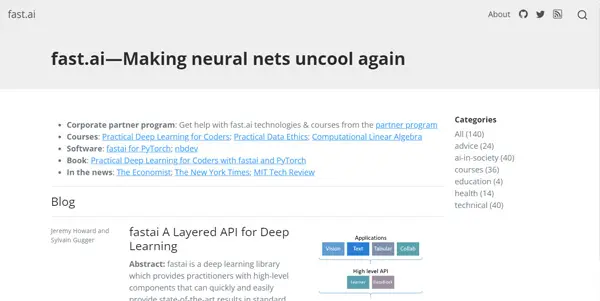Fast AI

Learn the basics of artificial intelligence until you become an AI expert
Fast AI: Democratizing Deep Learning
Fast AI is not a single tool, but rather a practical, project-based, hands-on approach to learning and applying deep learning. It provides a collection of resources, including courses, libraries, and documentation, designed to rapidly empower individuals with little to no prior experience in machine learning to build and deploy sophisticated AI models. While not a software application in the traditional sense, its impact on the accessibility of deep learning makes it a significant player in the developer tools landscape.
What Fast AI Does
Fast AI's core mission is to lower the barrier to entry for deep learning. It achieves this by focusing on:
- Practical Application: The learning methodology emphasizes building real-world projects from the outset, allowing users to immediately see the practical value of the concepts being taught. Theory is interwoven with practical implementation, ensuring a strong grasp of both.
- Intuitive Libraries: Fast AI provides readily accessible and easy-to-use Python libraries that abstract away much of the complex underlying mathematics and implementation details of deep learning algorithms. This allows developers to focus on model design and problem-solving rather than intricate coding.
- Step-by-Step Guidance: The courses and documentation provide structured learning paths, guiding users through each stage of the model building process. This makes the learning curve significantly gentler than traditional approaches.
Main Features and Benefits
- Rapid Prototyping: The streamlined libraries and clear tutorials enable users to quickly prototype and experiment with different models.
- High-Level API: The Fast AI library provides a user-friendly high-level API, hiding much of the complexity of underlying deep learning frameworks like PyTorch.
- Community Support: A vibrant and active community provides ample support and resources for learners, fostering collaboration and knowledge sharing.
- Accessible Learning: The courses are designed for a broad audience, requiring only a basic understanding of Python programming. No extensive mathematical background is initially necessary.
- State-of-the-art Techniques: Fast AI incorporates the latest advancements in deep learning, ensuring learners are equipped with cutting-edge knowledge and tools.
Use Cases and Applications
The practical nature of Fast AI lends itself to a wide range of applications:
- Image Classification: Building models to classify images (e.g., identifying different types of plants, diagnosing medical conditions from X-rays).
- Natural Language Processing (NLP): Developing models for tasks like sentiment analysis, text classification, and machine translation.
- Time Series Analysis: Predicting future values based on historical data (e.g., stock prices, weather forecasting).
- Computer Vision: Developing applications that involve image recognition and object detection.
- Anomaly Detection: Identifying unusual patterns or outliers in data.
Comparison to Similar Tools
Compared to other deep learning frameworks like TensorFlow or PyTorch, Fast AI prioritizes ease of use and rapid prototyping. While TensorFlow and PyTorch offer greater flexibility and control, they often require a more significant investment in learning and understanding the underlying complexities. Fast AI acts as a bridge, allowing users to quickly grasp core concepts before potentially transitioning to more advanced frameworks. Other online courses might provide theoretical knowledge, but Fast AI distinguishes itself through its project-based learning and readily usable libraries.
Pricing Information
Fast AI's core resources, including the courses and libraries, are completely free to access and use. This open and accessible approach significantly contributes to its popularity and impact on the democratization of deep learning.
Conclusion
Fast AI represents a significant advancement in making deep learning accessible to a wider audience. Its focus on practical application, user-friendly libraries, and comprehensive learning resources empower individuals and organizations to leverage the power of AI without the steep learning curve typically associated with this field. Its free and open nature further underscores its commitment to democratizing this transformative technology.